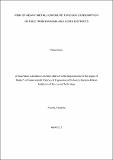| dc.description.abstract | Heavy metals exposure is associated with various human health problems. This research aimed at determining the levels of heavy metals in paddy soils and in polished rice from villages around the artisanal gold mining areas in Kahama and Geita districts. It also intended to assess the risk of human exposures of heavy metals through rice consumption around the artisanal gold mining areas in Kahama and Geita districts, Tanzania. Twenty soil samples were collected from paddy fields and 20 polished rice samples grown from those fields were taken from the farmers. An additional 20 polished rice samples were collected from farmers in other villages from the same districts. Information about rice cultivation practices and rice consumption were collected from 40 farmers that were randomly selected, 20 from each of the two districts; Kahama and Geita districts, in which the mining areas are located. Chromium (Cr), copper (Cu), zinc (Zn), Mercury (Hg), cadmium (Cd), nickel (Ni), lead (Pb) and arsenic (As) were determined in the soil and rice samples using Energy Dispersive X–ray Florescence spectrometer. Heavy metals exposure through rice consumption, for each of the forty farmers, was determined using deterministic approach. In all the soil samples, concentrations of Cd and Cr were found to be above the maximum limits of 1 mg/kg and 100 mg/kg, respectively, as set by Tanzania Bureau of Standards (TBS). Concentrations of Pb and Cd in all the rice samples were above the maximum limits set by Codex Alimentarius Commission. Forty percent of the farmers consumed rice at least once daily with per capita consumption of 66.8 g per day for Geita district and 74.0 g per day for Kahama district. According to Joint FAO/WHO Expert Committee on Food Additives (JECFA), the estimated daily intake (EDI) for Cd was found to be above tolerable daily intake (TDI) for 95% of all population in both Kahama and Geita districts while the estimated daily intakes (EDIs) for As, Zn and Cu in both Kahama and Geita population were below the TDIs. The results also showed that sites which are closer to the mining activities had higher heavy metal concentration in both rice and soils compared to the sites further away from the mining activity. | en_US |

